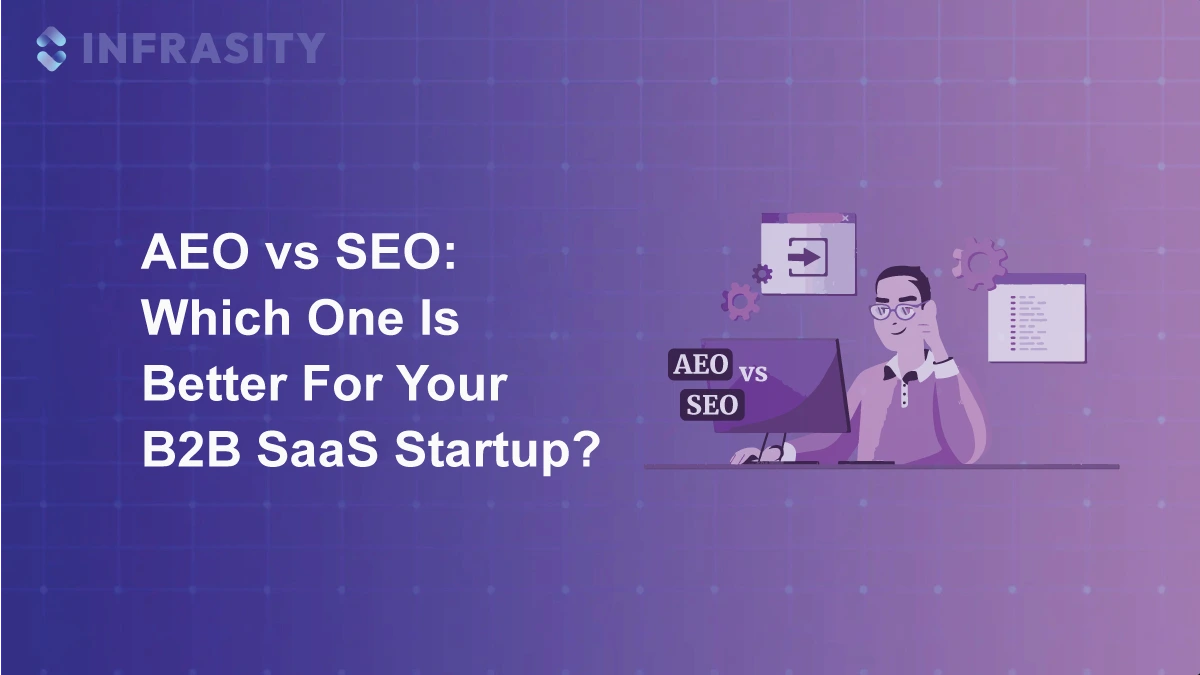TL;DR
- AEO is the process of optimizing content to be easily understood and surfaced as direct answers by AI tools, like Google AI Overviews, ChatGPT, Copilot, or voice assistants - through both text and voice search.
- SEO is the process of optimizing content with relevant keywords to improve a website’s visibility in search engine results and attract organic traffic from users searching for information, products, or services.
- AEO vs SEO: While AEO helps you gain visibility in zero-click searches in the short term, SEO enables you to achieve visibility and engagement in SERPs in the long term.
With the rise of AI-powered tools like ChatGPT, Google’s AI Overviews, and voice assistants, the way people search and find information online is evolving faster than ever. If you're a B2B SaaS startup leveraging content marketing, chances are you’re already investing in SEO to boost visibility, rank higher, and drive organic traffic. But there’s a new term gaining traction in the content world: Answer Engine Optimization (AEO).
So what exactly is AEO? How does it differ from traditional SEO? And more importantly, should your startup prioritize one over the other, or combine both to future-proof your growth? In this article, we’ll break it all down: what AEO really means, how it compares to SEO, and how to decide what’s right for your content strategy in this AI-driven search landscape.
Let’s dive in.
What is AEO?
Answer Engine Optimization (AEO) is the process of structuring and optimizing your content so it can be easily understood, extracted, and presented by AI-powered assistants, such as Google’s AI Overviews, ChatGPT, Microsoft Copilot, Alexa, or Siri as direct responses to user queries through either voice search or text search. Additionally, it helps in getting your content visible in featured snippets. Suppose you have written an article titled “What is Trunk-Based Development?” and include this clear opening:
“Trunk-based development is a version control strategy in which all developers commit changes to a single main branch (‘trunk’) to reduce integration conflicts and support continuous integration and deployment.”
If this definition is used by Google in a featured snippet or by ChatGPT as a cited answer, it reflects successful AEO, delivering value to users instantly while boosting your website visibility in AI-driven ecosystems.
Tired of wasting engineering time on content?
What is SEO?
Search Engine Optimization (SEO) is the process of improving a website’s visibility in search engine results pages (SERPs) by optimizing its content by infusing relevant keywords to attract organic (non-paid) traffic. The primary goal of SEO is to help your content rank higher for relevant search queries, so users can discover it when searching for information or some SaaS products or services.
For example, you have published a blog post titled “Top 7 Python Code Review Tools for 2025,” which is optimized with keywords like Python code review tools, and internal links to related DevOps content. Because of these SEO best practices, your article ranks on Google’s first page for the search query “Python code review tools,” and developers searching for that topic click through to your site organically.
What is AEO vs SEO: Key Differences
Now that you know the basic difference between AEO and SEO, let us compare them comprehensively in terms of several aspects like Content, User Intent, and Keywords. Here’s a comprehensive comparison between each technique:
1. AEO vs SEO: What’s Their Main Focus?
When it comes to SEO, the focus has always been on improving the webpage’s visibility on the first page of search engine results. The ultimate goal is to rank in the top 3 positions, making it more likely for users to click and visit your site. For example, here you can see that the webpages are ranking on the first SERP for the keyword “code review best practices.” This allows these websites to gain traffic from their target users.
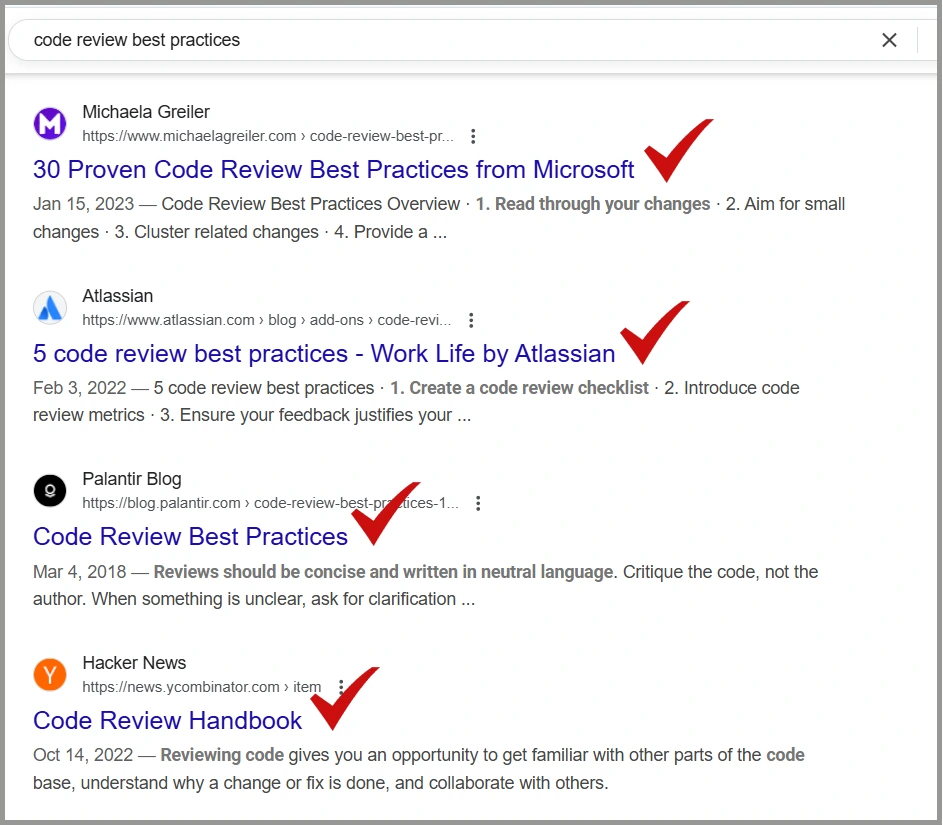
Answer Engine Optimization is utilized to ensure your content is picked up and presented by AI-driven platforms like Google’s AI Overviews, ChatGPT, Siri, or Alexa. Here you can see that Google’s AI overview has provided links to a few articles and a YouTube video.
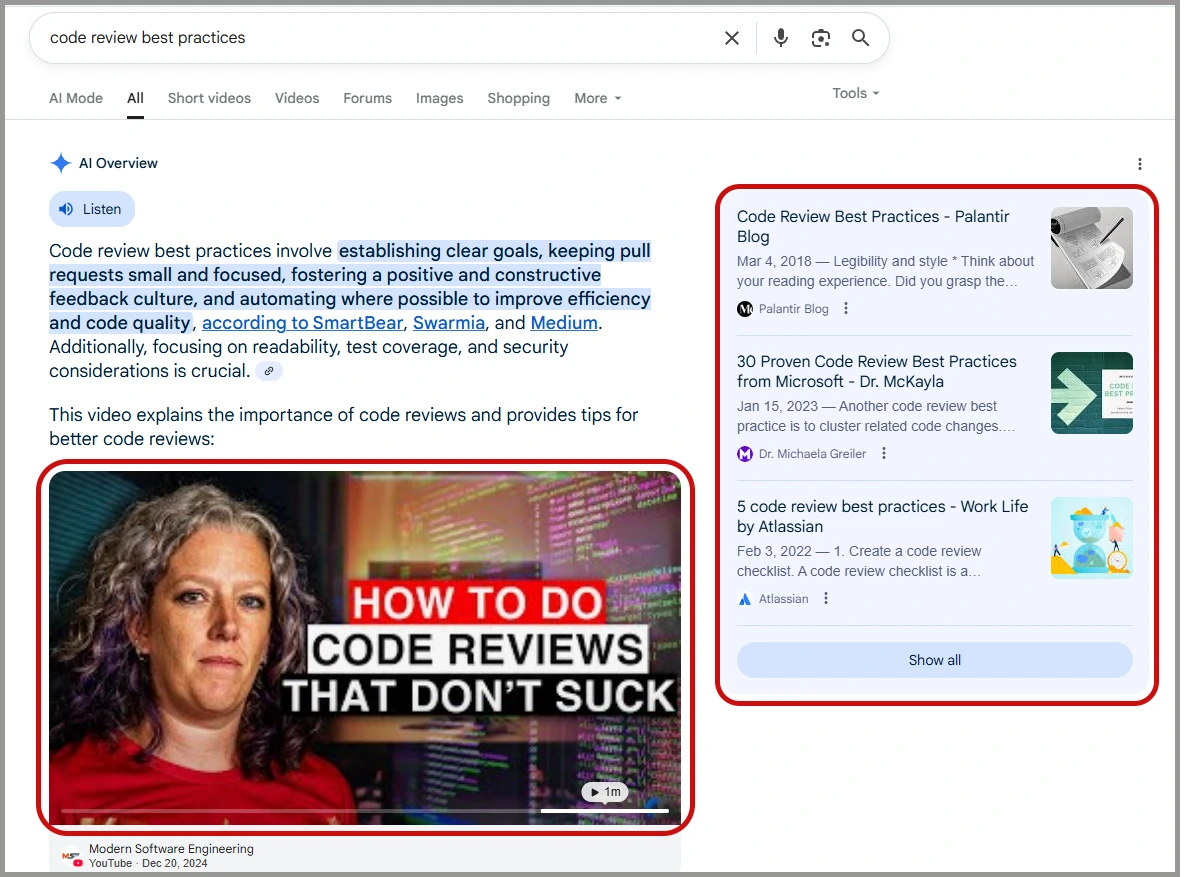
2. AEO vs SEO: Which One Works For Specific User Intent
User intent refers to the purpose behind a user’s query, what they’re trying to accomplish when they type or speak a question or a phrase. There are four primary types of user intent:
Informational: The user wants to learn something.
Example: “What is trunk-based development?”Navigational: The user wants to go to a specific website or page.
Example: “GitHub login” or “Python official site”Transactional: The user intends to complete an action, often a purchase.
Example: “Buy VS Code license”Commercial: The user is comparing options before making a decision.
Example: “Best static code analysis tools for Python”
SEO strategies aim to cover all four types of intent. Whether a user is looking to buy, compare, navigate, or just understand something, SEO content is created to attract clicks across ToFU, MoFU, BoFU stages of the marketing funnel. For instance, an article targeting the keyword “best code review tools” (with commercial intent) is optimized to rank high and persuade users to visit your site for a deeper comparison or purchase.
AEO, on the other hand, is primarily focused on informational intent. It’s built to deliver immediate, clear answers to users asking specific questions, often in the form of voice search or AI-powered queries. For example, if someone asks “What is trunk-based development?”, an AEO-optimized answer appears in a featured snippet or AI response box, fulfilling the user’s need without requiring a click.

3. SEO vs AEO: Which Keywords Are Crucial For Both
Keywords are the foundation of any search optimization strategy. They represent the exact terms and phrases users type or speak when searching for information. In SEO, the goal is to target a mix of:
- Short-tail keywords: Broad, high-volume phrases like “code review tools” or “project management software.”
- Long-tail keywords: More specific, lower-volume phrases like “best Python code review tools for teams” or “open-source project management tools for startups.”
SEO uses these keywords to improve rankings and drive organic traffic. For example, an SEO-optimized article might be built around keywords like “top Python code review tools,” strategically placed in the title, headers, metadata, and throughout the content.
In AEO, the focus shifts toward question-based, long-tail keywords that reflect how people speak to voice assistants or ask questions in AI tools. These include:
- Direct questions like “What is RAG?”
- Intent-driven phrases like “How does RAG handle bias and misinformation?”
Rather than stuffing content with keywords, AEO uses them to create structured, conversational answers. For example, a question in a subheading followed by a concise 40–60 word answer helps search engines and AI models understand and extract your response for featured snippets, AI, or voice search results. For example, here the article by AWS consists of a definition of RAG, which is extracted by Google’s AI.

4. AEO vs SEO: Which Type of Content Works Better?
Content is the foundation of both SEO and AEO; without it, none of the strategies can be effectively executed. Whether you're aiming to rank in search engine results or appear in AI-generated answers, content is the one that delivers your message, builds authority, and meets user intent.
To utilize SEO effectively, content should comprise in-depth details, so it ranks for a wide variety of search queries, meets more than one user intent, and encourages users to stay on the page. For example, you can see here that these articles are ranking in the top 3 positions of Google’s first SERP for the keyword “best code review tools.”
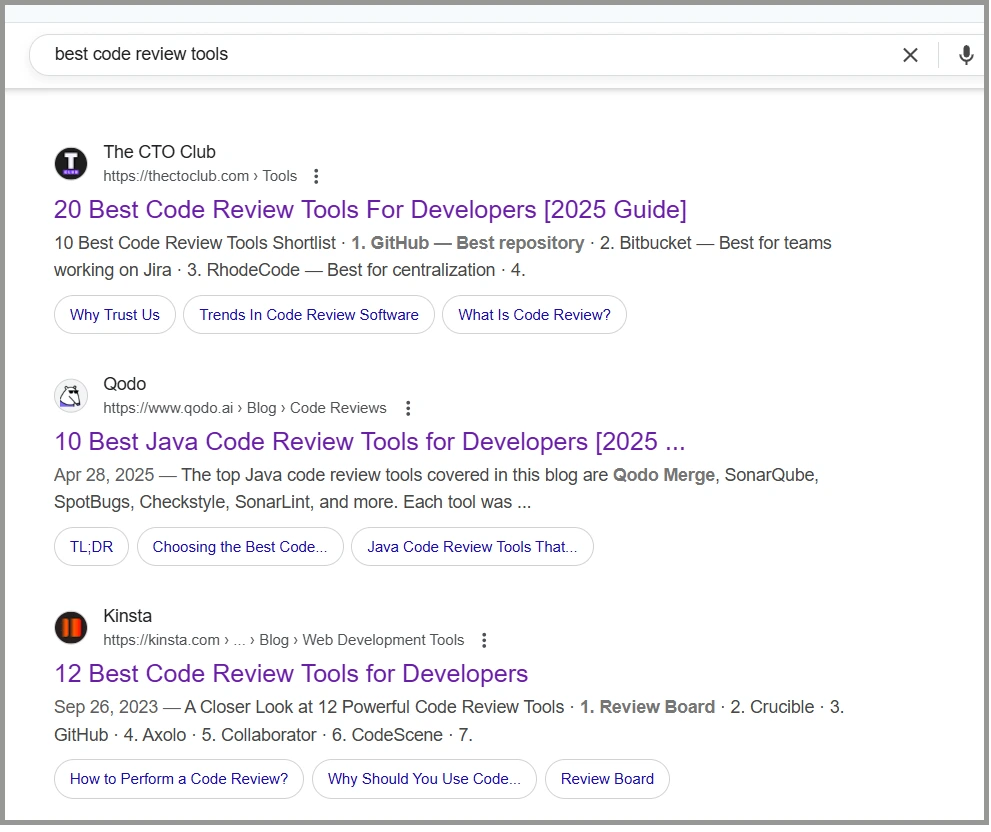
The reason behind these articles' ranking is that they have not only mentioned the tools but also discussed the tools’ special features and their pros and cons.
The AEO technique is utilized by creating content that is concise, direct, and definition-based. This is because AEO thrives when the content is written in a way that answers the direct queries searched by the target users. For example, Google’s AI Overview will suggest some articles when you search the keyword “how does GitHub Copilot work?”
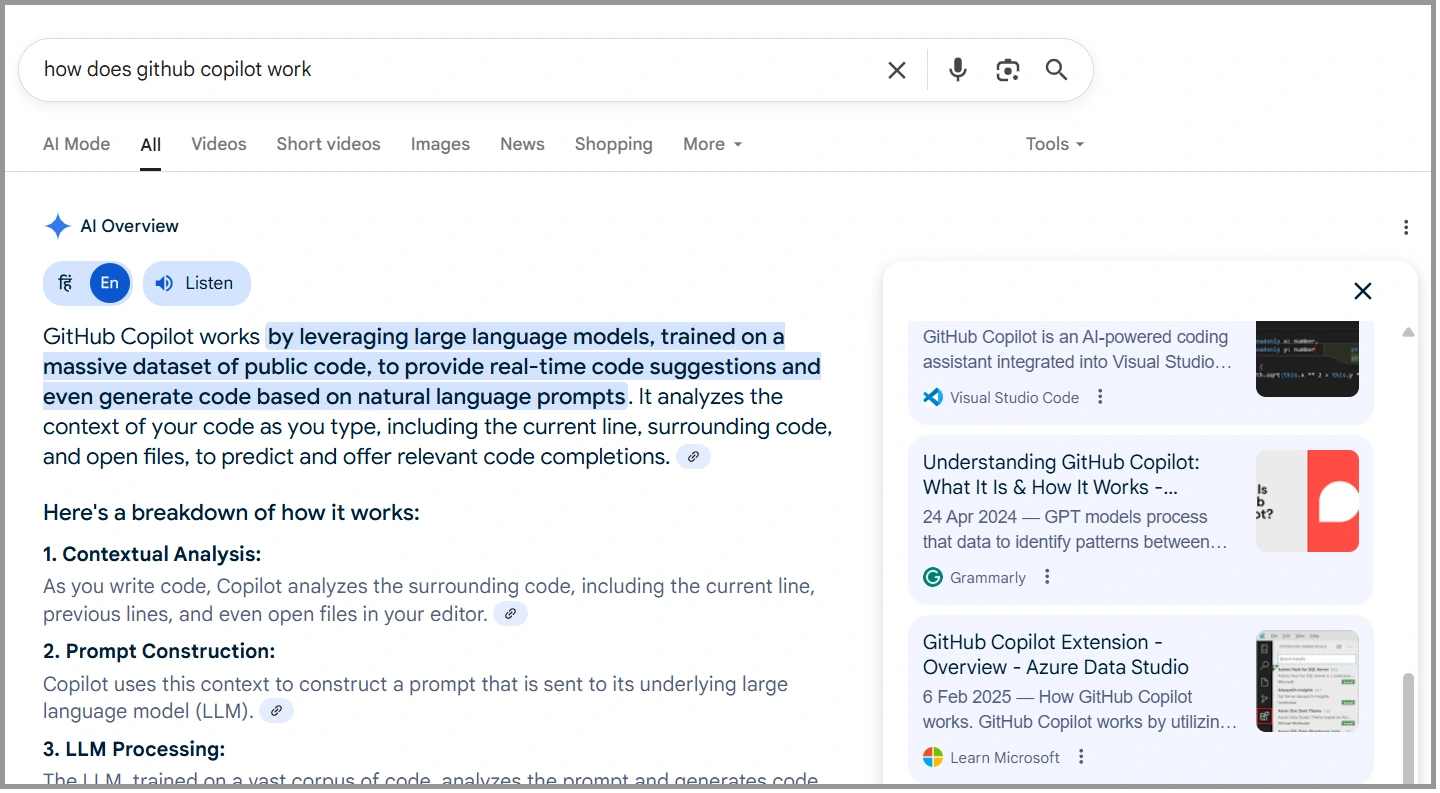
These articles are suggested because the AI can extract the information from websites that have covered the required topic. Here you can see that Microsoft has discussed the exact information that was asked in the query.

This format helps your content appear in featured snippets, AI Overviews, or voice responses, making your website visible.
5. SEO vs. AEO: Timeframe for Visible Results
Timeframe is a critical factor that sets SEO and AEO apart - not in terms of value, but in how quickly results can be expected and how each strategy compounds over time.
SEO is fundamentally a long-term strategy. It takes time to build domain authority, earn backlinks, improve technical health, and climb search rankings. You may not see immediate results, but the payoff compounds, meaning that it brings in consistent traffic, leads, and conversions over months or even years.
AEO, in contrast, can yield short-term or immediate visibility, especially when you're targeting trending queries or voice-friendly questions. It’s about being agile - identifying what people are asking now and answering it quickly in a way that’s optimized for AI, voice search, and featured snippet results.
AEO vs SEO: Which One Should You Practice?
In today’s evolving search landscape, both SEO and AEO are essential, but their importance depends on how and where your audience is searching.
AEO Is Essential for Zero-Click Search Visibility
A growing number of searches now end without a single click to a website. These are known as zero-click searches, where users get their answers directly on the search engine results page (SERP) via featured snippets, AI Overviews, or voice assistant replies.
According to a 2024 study by Semrush, over 58% of Google searches now result in zero clicks. AEO helps you take advantage of this shift by formatting your content in a way that makes it more likely to:
- Appear in featured snippets
- Be cited in Google’s AI Overviews
- Serve as spoken answers in voice search tools like Siri or Alexa
Even without earning a click, this kind of visibility builds product awareness, authority, and user trust.
SEO Remains Vital for SERP Rankings and Organic Traffic
While AEO dominates the zero-click space, SEO remains the backbone of long-term digital visibility. It’s still crucial for:
- Ranking content for all kinds of search intent queries
- Driving qualified organic traffic to your site
- Building domain authority through in-depth content
SEO supports every stage of the buyer journey - from awareness to conversion, and is especially important for SaaS companies.
How to Integrate AEO with Traditional SEO Strategies?
To increase your visibility, the smartest approach is to combine AEO with SEO. Here’s how:
1. Answer First, Then Dive In Comprehensive Details
Start key sections of your content with concise, question-based answers that AI can easily extract. Then follow with in-depth explanations, visuals, comparisons, and supporting data to serve SEO goals.
Example: Start with: “Trunk-based development is a version control strategy where all developers commit to a single branch, enabling continuous integration.”
Then expand with use cases, pros/cons, and tools that support the method.
2. Use Schema Markup
Schema markup is a form of structured data that helps search engines and AI tools better understand your content, making it eligible for enhanced features like featured snippets, rich results, and AI-generated answers.
For SEO, it supports better indexing and eligibility for SERP enhancements, while for AEO, it increases your chances of being cited in AI Overviews or voice search results. Common types include FAQ Page (for Q&A sections), How-To (for step-by-step guides), Article (for blog clarity), and Speakable (for voice assistants).
3. Structure Content Clearly
To optimize for both SEO and AEO, structure your content in a way that is easy for both humans and machines to scan, understand, and extract. Use H2 or H3 headings phrased as questions, and follow each with a concise answer in the first 40–60 words. For explanatory content, use bulleted or numbered lists to break down features, steps, or pros and cons.
This structure increases your chances of being included in People Also Ask, AI Overviews, and voice assistant answers, while also enhancing user experience and engagement for traditional SEO.
4. Monitor Both Traditional and AI Metrics
Track SEO performance via Google Search Console and keyword ranking tools, while monitoring AEO impact by:
- Searching key questions to see if your answers appear in AI Overviews
- Tracking featured snippet inclusion
- Auditing citations in ChatGPT or Perplexity using Google Data Analytics Tool
5. Balance Short-Form and Long-Form Content
Use short-form content for AEO (definitions, FAQs, glossaries), and long-form content for SEO (how-to articles, listicles, comparison-based articles). This dual approach helps you dominate both AI and traditional search ecosystems.
Every devtool startup needs content. Most do it wrong.
Conclusion
SEO and AEO are no longer either-or strategies; they're two sides of the same visibility coin. While SEO builds long-term traffic through rankings, AEO secures short-term visibility in AI-driven, zero-click environments. By combining structured, answer-first content with in-depth, keyword-optimized pages, you can stay visible across both traditional search and emerging AI platforms - maximizing reach, relevance, and results.
If you are a B2B SaaS company and utilizing content marketing but still not getting the desired results in terms of visibility, engagement, and product adoption, partner with Infrasity for technical writing services. We ensure that your blogs are not just technically accurate but reach your target audience through search engines, AI tools, and voice search.
FAQs
1. What Is the Difference Between SEO and AEO?
SEO focuses on improving website visibility in traditional search engine results through keywords, backlinks, and technical enhancements. AEO is about structuring content to directly answer user queries in AI-powered platforms like Google AI Overviews or ChatGPT.
2. What Is an Example of AEO?
An example of AEO is when your article appears as a featured snippet on Google, directly answering a user's question like “What is trunk-based development?” above all other results. This allows you to gain visibility among your target users and make you the authoritative source in a zero-click search.
3. Which Is More Important AEO or SEO in Upcoming Days?
Both are important, but AEO is becoming increasingly critical as AI-driven search and zero-click behaviors rise. However, SEO remains essential as it supports discoverability, technical health, and depth of content that AEO builds upon.
4. How Is AEO Different Than SEO?
AEO targets AI systems and voice assistants by providing structured, concise answers optimized for direct results. SEO, on the other hand, targets ranking on search engines like Google and aims to drive traffic through clickable listings.


